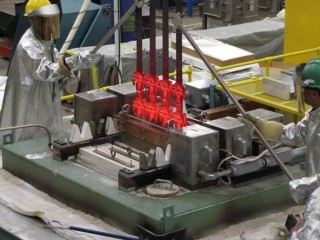Aug 14 2015
Researchers at the U.S. Department of Energy’s Argonne National Laboratory have developed a newly patented technology that can considerably increase the life of mechanical components.
Metal parts integrated in industrial machines undergo significant wear and tear. In order to protect and extend the lifetime of machinery, a number of surface hardening methods has been developed such as pack-boriding, which deposits a boride layer on metal pieces during boron diffusion.
Distinguished Fellow Ali Erdemir’s work has improved on this traditional boriding method, which not only takes up significant amount of time, but is also labor-intensive. To resolve this issue, the researchers developed a process for ultra-fast boriding that saves time, energy and cost, while reducing environmental concerns.
 Argonne researchers Osman Eryilmaz (left) and Gerald Jeka (right) recover industrial parts from the large-scale ultra-fast boriding furnace after a successful boriding treatment. This process for extending the lifetime of mechanical parts, which just received its U.S. patent, saves time, money and energy compared to conventional technique, and even alleviates environmental concerns.
Argonne researchers Osman Eryilmaz (left) and Gerald Jeka (right) recover industrial parts from the large-scale ultra-fast boriding furnace after a successful boriding treatment. This process for extending the lifetime of mechanical parts, which just received its U.S. patent, saves time, money and energy compared to conventional technique, and even alleviates environmental concerns.
Over the past three years, the research team adopted an abstract idea and converted it into a large-scale furnace, which can deposit a 100µm-thick boride layer in just a matter of 30 minutes. However, it will take roughly 10h to acquire the same level of thickness through the pack-boriding method.
The team successfully completed the process and now has received a utility patent, which encompasses the technology’s ultra-fast nature, the variety of materials that can be treated, and the specific steps involved in the ultra-fast boriding process. This innovative technology was described by Erdimer as “clean and green, cost-effective and energy-efficient.”
In the pack-boriding method, parts have to be baked in a mixture of powders at 1,800°F for a period of 10 hours or more. In contrast, the ultra-fast technique utilizes a battery-like design to direct the reactive boron within the metal surfaces. The furnace is similar to a battery, and depends on the attraction between negative and positive charges to allow boron to flow quickly toward its destination.
Since boron is supplied very quickly, the layers created through the ultra-fast boriding method are more thick and uniform when compared to the layers obtained through the standard pack-boriding technique. In addition to being faster, ultra-fast boriding also produces tougher layers than other alternative options available for surface hardening, such as the use of nitrogen or carbon instead of boron.
If a protective layer is thick, it would not crack easily or come loose, thus extending the longevity of metal parts and rendering them more reliable and consistent in the long term. Machines that are durable and those that need minimum maintenance for their components could be more cost-effective.
Erdemir informed that the heating process involved in the pack-boriding technique alone makes it labor-intensive. In contrast, the ultra-fast boriding method can do a better job and at the same time uses 80 to 90% less energy. The powder mix-based boriding also emits carbon dioxide gas and other harmful emissions, while the ultra-fast process practically eliminates these emissions.
Not many people would look at a farming tool, a car or an airplane and appreciate the robust layers protecting its components, but depositing this protective layer is a critical step that enables machines to operate with continues use.
This comprises automobiles with components facing the burden of corrosion, erosion and heavy loads. In the aerospace sector, a large number of components are made from titanium. However, this metal would be much more resilient if is subjected to the ultra-fast boriding process.
“The application conditions for all kinds of machinery are getting harsher,” Erdemir said. “The conventional approach to surface hardening is just not enough to sustain these machines.”
Erdemir added that tools utilized in farming, mining, and oil and gas exploration are quite sensitive to wear and tear, but the latest technology could aid in preserving this equipment.
“It feels great to get this patent,” Erdemir said “because it’s very exciting to see something start at the demonstration level and reach the full production level. We have real fruits to show for our labor, and we’re proud of this rapidly-growing technology that will hopefully be up and ready for commercial practice by the end of this year, if not by this fall.”
The research team has partnered with a private industry partner to translate the industrial-scale furnace into commercial use. Erdemir intends to enhance the surface hardening method, but for now he is happy that the ultra-fast boriding method is close to its first commercial application
The U.S. Department of Energy’s Office of Energy Efficiency & Renewable Energy, Advanced Manufacturing Office funded the three-year project, which led to this patented ultra-fast boriding technique.